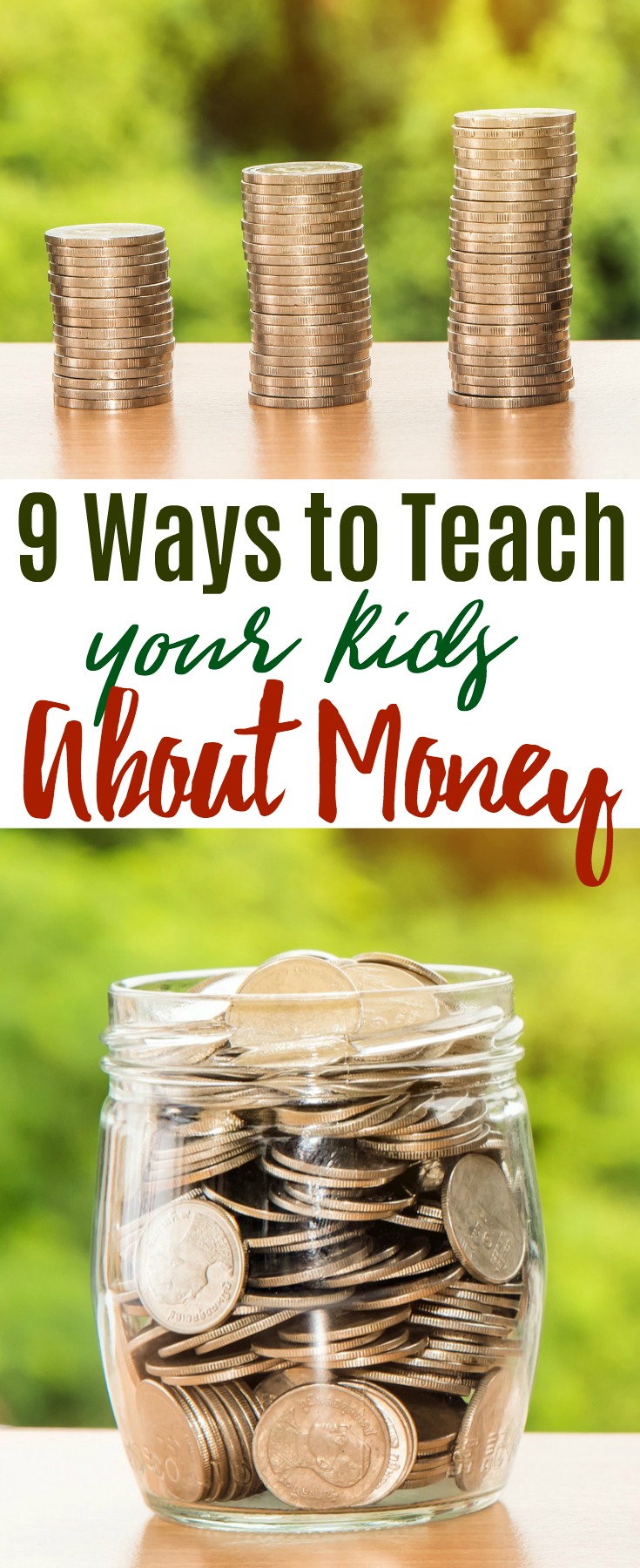Sometimes some of the best life lessons are taught within the confines of your house. Here are 9 ways to teach kids about money.

Things like geography, history, spelling, and even math — most of our kids learn quite a bit in school. From the age of 5, when they are in kinder, through the age of 18 when they graduate.
They spend a lot of time learning, practicing for tests, testing, and then learning again. (Maybe I should say.. testing again). In some cases, it seems like they test much more than they probably should (but that’s another subject!)
Life Lessons are So Valuable
No matter what they learn in school, one thing is certain. It’s the things that they learn inside the walls of your home that matter the most. The younger you start teaching your children about money, the greater understanding they will have of the power of the dollar.
They will hopefully learn the difference between needs and wants, gratitude versus lack thereof, and hopefully start their own family with a better grip on their own finances.
Years down the road when they leave the nest. Or at least we hope.
When I look back at my childhood, one thing I wish I would have had the opportunity to learn more about is managing money. I did learn how to open a bank account and write checks at the age of 18, but I wasn’t sure how anything else worked. My parents didn’t take much time to sit us down to talk to us about the intricacies of finances.
They were too occupied with raising four kids, running a business, and making sure our needs were met. I think that’s something that many of us do now.
Now that you are in your adult years (some of us more than others), there is no better time than now to help your kids expand their knowledge on the subject of money. It’s never too early to start the conversation and no better time than the present to get them going on good money habits.
9 Ways to Teach Kids About Money
So how do you teach your kids about money? It varies greatly depending on age – our kids range from 2 to 12, and so it’s quite a challenge to teach them all as a collective group. It’s much easier, however, to break them down into age groups in hopes that they gain speckles of insight as they grow through the years.
#1: Lead by Example
Your little ones watch your every move. You are their role model. They look up to you and want to be you. Do not be surprised, when you check on your kiddo, while they are playing in their room and they are pretending to be you!
But this is why it is important to start using cash. If they see you paying for groceries with a credit or debit card, they will instantly think the card is magic. Show them that you are buying products with cash, instead of that magical card.
(Understandably many people are unwilling to carry cash – this subject can be a hot debate, I agree! We have used cash for years — and have yet to incur a problem. If anything, cash prevents us from overspending … Its easier to curb spending when green is in hand versus a simple swipe of plastic).
#2: Help them Save with a Clear Picture
Many kids opt for a piggy bank. It’s a popular savings vehicle that’s often marketed to kids. I have even spotted them in the 99 Only store for just a few dollars. While the concept is great, kids are very visual (at least mine are).
Our kids save with a clear jar. That jar allows them to see the money accumulate. That accumulated money creates a build in excitement for our younger kids. There are times when they will have dollars in there, and others when they will drop quarters in.
No matter what goes in, the jar accumulates by the day as they raid Dad’s pants pockets for his spare change every night.
An accumulated vision creates excitement. Excitement is what motivates them to continue to save.
#3: Show them that Things Cost Money
Kids need to understand that things that they want cost money. By involving them in your cash purchases (ie. purchasing gas in the gas station, or shopping at the store, paying for produce at the farmers market in cash, etc.) they will identify the item with the cost.
Every few weeks, I’ll send my kids in to the farmers market to pick up our vegetables and give them the dollars. I *hope* that they don’t get excited and head for the bakery table first before picking up our produce bag.
More times than not, our oldest son is responsible enough to pay for the vegetables, and pocket the change. He will then bring the bags to the car and cheerfully hand me the money.
(He will then say “you have $2 left, can I buy 2 cookies please?) But at least he comes to me first to ask :)
It’s important for kids to be able to match items with money. Hand to money, so that they realize that things do cost and that cost is actually hard earned dollars.
#4: Help them Create a Wish List
Help your child create a wishlist. They can put anything and everything that they want on the wishlist. After all, it is just a wishlist! Having a list of everything they want, will help them prioritize. When it is time to spend some of their money, they will learn that they may not have enough money to purchase all of the items on the list.
However, they will quickly learn about needs and wants and which one is most important. This way when it comes down to deciding what they will buy, later on in life, they will be able to prioritize financial decisions better.
Perhaps your kids want a LEGO set and a pack of NERF darts – but their saved money doesn’t permit both. A wish list will allow them to prioritize between which one is more important at that time. They’ll have to wait patiently for the other item until they have worked hard enough to save. This works wonderfully.
#5: Allow your Kids to Earn Commission
It’s easy to give your kids an allowance. Instead of an allowance, allow them the opportunity to earn commission based on things they do at home. Certainly some things are expected of them, but anything over those expectations should be rewarded with commission.
Our oldest is wonderful at helping with the baby — bathing, dressing, dressing, even washing blankets that she uses. Our boys are helpful (when they want to be!) at picking up and mopping if they know a commission payment is involved.
Those commissions are money that they earn (not just given) when they show the determination to put forth effort. I always tell my kids that I love it when they do things at home. However… I love it more when they do them unexpectedly without mom having to ask. Those are the best opportunities for learning!
#6: Teach them about Giving
Once your kids start making a little earned money, it’s important for them to learn how to divvy up their earnings to not only save, but also to give. Giving is so important! Kids should be given the choice to give to their local church, a local charity or, even a family who may need help.
Hopefully the habit of giving will compound over time and they will start their adult life with a greater understanding that money can affect those that are around us. Especially those who are in need of help.
#7: Teach them Gratitude
We all live in a culture that is overwhelmed with things – whether adult or child, we all want too much stuff. We have too much stuff. And unfortunately kids today grow up with everything from an iPhone, kindle, a TV in their room, or even their own brand-new car.
Gasp!
I remember the first vehicle I had at the age of 16 – a Ford Aerostar minivan, with two captains chairs in the middle, was my ride. At the time, this was considered a desirable vehicle – the Minnesota salt had rusted the undercarriage but it was a wonderful van to drive.
Kids now have beautiful cars, some even BMW’s. That almost have me convinced they make payments, payments that are truly unnecessary for kids at their age.
It’s important for parents to help children understand the true meaning of gratitude and contentment. Materialism usually stems from people looking outside themselves for happiness and fulfillment. And while buying stuff may make you feel better, it’s only a temporary fix. If we focus on being happy and fulfilled, then perhaps we can avoid the desire to buy more stuff to make us happy. That goes for kids, too.
Being content also plays a large role in helping our kids learn how to manage money.
#8: Help them Open a Bank Account
Many parents open up college funds for their children in the form of a 529 plan. Others might even have an additional (regular) money market account as well. If you have a teenager, it might be time to introduce a simple checking account to help them gain a better understanding of managing their money.
Though they may not have a large balance, it will help them manage a greater balance as they grow in years.
#9: Help them Find a Job
As your teenagers grow in years, so does the opportunity for them to work at a job. Unlike us adults, kids have quite a bit more free time. Offer your son or daughter the chance to find a job for winter break, or summer break, so that they can earn money to tuck away for their future car. There are many opportunities for high school students to work part time and save up for the expenses that will come when they have a drivers license.
Oh the joy…
When you teach kids about money, it won’t always be the easiest task. Heck, it can be hard for me to talk to my husband about money and he’s well into adulthood at this point. If anything, it’s a sacrifice. If you want your kids to earn a better understanding of how money works, there is no better time than the present.
I’d rather my kids learn about money from the parents who helped raise them for 18 years over a complete stranger or money mailer. t have their best interest at heart.




Leave a Reply
You must be logged in to post a comment.